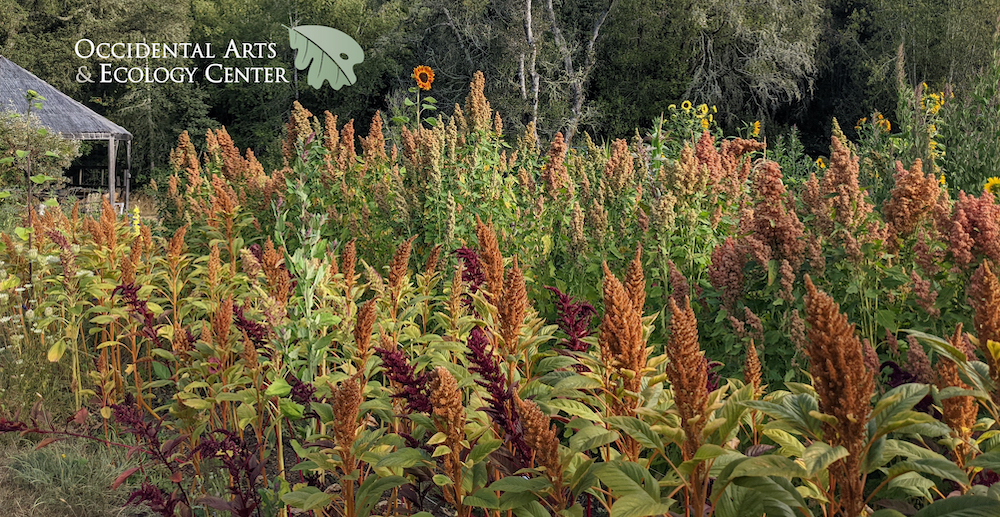The old saying “Don’t miss the water ‘till the well runs dry” couldn’t be more apt in this year’s unprecedented drought. Wells and reservoirs are drying up around the county, the CA State Water Resources Control Board is implementing restrictions throughout the Russian River watershed, and neighboring small farms have been forced to cancel their CSAs or severely curtail their growing expectations for the season. Despite OAEC’s many efforts to save water, our situation is no exception. The OAEC pond, which was built in 1978 in response to the last mega drought in 1976-77, supplies all of the agricultural water for the Mother Garden, nursery, and landscaping for the entire OAEC site as a separate source from the potable well. The pond has never been this low in its 43-year history.
Fed entirely by surface water run-off, the pond normally fills to capacity by late December or early January, and rarely as late as early February, but this year, it never filled, even by the last rain in late March. Early warm weather increased evaporation and warranted starting irrigation to the gardens sooner than it would normally be needed. By summer solstice, these compounding problems meant that the volume of the pond was 50% of its maximum capacity (compared to 95% capacity in June of 2019), well before the truly hot, dry summer weather started in earnest.
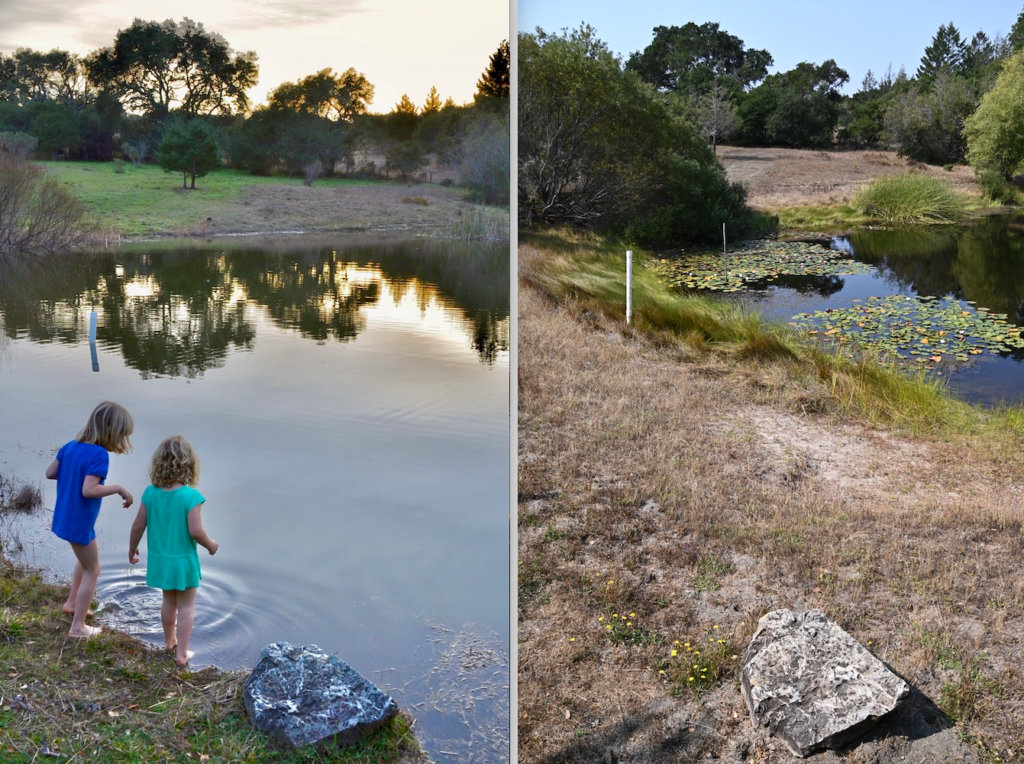
The OAEC staff and residents collectively realized that we cannot continue to “prepare” for an emergency. This was the emergency. The time to make radical shifts in water use was NOW! By June, Site Manager James Pelican started installing additional meters, crunching numbers, and writing weekly missives to staff and residents. He implored:
“I am doing an up-to-date analysis of our irrigation water usage and I am concerned at what I am discovering. The short of it is that AT OUR CURRENT RATE OF USE, WE WILL RUN OUT OF POND AG WATER BY THE END OF SEPTEMBER. I estimate that we will need to use about a third less water than we do in a typical year to make it through until the next rains… Please refrain from using overhead watering as much as possible – drip and hand watering are 4 times more efficient. If you need to use overhead, use a timer and only water enough for subsistence, letting planted areas go dormant with just enough watering to keep things alive.”
The garden and facilities crew sprang into action. Many garden beds were immediately retired for the season and aspirations of further plantings have been postponed until the rains return. Much of the landscaping around our newer main buildings had been installed originally using drip irrigation, but the main agricultural growing sections – the entire North and South Garden annual beds – needed to be converted to drip, followed by the perennial borders, and finally, landscaping around the many other Center buildings and private resident homes. Since pond water is biologically active/turbid with particulates and will only get increasingly murky as the level drops, installing a costly new low-micron filter to prevent clogging of fine drip emitters was also a key component of our upgrade.
Garden and Facilities crews digging trenches for the new pipes. Many thanks to Luke Reppe, Mile Horobin, Chris Santana, Jim Coleman, Fiona McNichols, Steven LaGatta, James Pelican, Michelle Krieg and Doug Gosling for this heroic team effort!
Thankfully, at the end of July after converting most of the planted areas of the land to drip irrigation, James was happy to report:
“As we move through mid-summer, I am relieved to see that our efforts to reduce the use of irrigation water are paying dividends. We have achieved a 73% reduction in use. At our current rate of use, we will have enough water to keep gardens (North, South, and at homes), landscaping, and both nurseries irrigated. While the current level is at the lowest level for this time of year on record, we are now only about two weeks behind the former lowest mark for mid-July set in 2008.”
Wanna geek out on the water calculations? Here’s our data on historical pond capacity, output, and daily water use: Pond Water Calculations
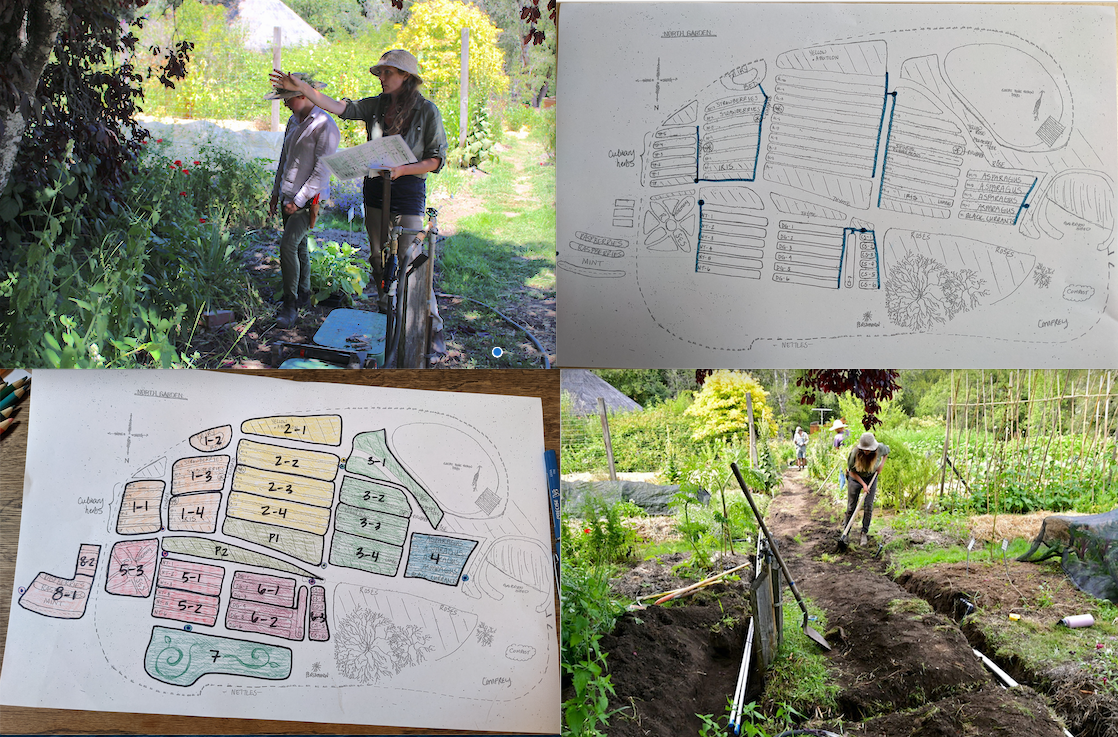
As home to the WATER Institute and the Conservation Hydrology Demonstration Site, we are obsessive-compulsive water-savers and have implemented over the years a host of water-saving techniques – rainwater catchment systems, laundry-to-landscape greywater installations, composting toilets, storm water capture/ground water recharge through on-contour infiltration ditches called swales – the list goes on and on. (See our conservation hydrology demonstration site and downloadable DIY projects here). However, the one area where we always erred on the side of generosity was with our ag water. The pond afforded us 43 luxurious years of bounty. Oooh, how we loved our overhead sprinklers! The data on drip irrigation is clear – it is known to save at least 4x times the amount of water than overhead watering. So, you may be asking…
Why didn’t we convert to drip sooner?
1) We hate plastic! Drip irrigation requires a lot of it. We are reluctantly accepting the tubing, filters, pumps, and timers associated with drip systems (as well as the cost and time of maintaining them) as necessary evils for now, though in our heart of hearts we want to #breakfreefromplastic. The idea that technological fixes (lithium batteries, geoengineering, “smart appliances”, etc) will save us from climate change is a fallacy. We acknowledge that the only way forward is through building forms of governance, economy, culture and infrastructure that de-incentivize extraction and over-consumption at every level and instead incentivize reduction, re-use, and ecologically regenerative co-management of the commons.
2) The pond, up until this year, has never even come close to running out of water. Being purely rain-fed, it’s a self-regenerating system under normal conditions. Climate change is not a normal condition. Mediterranean climates, by their nature, have a drastic difference in the water cycle between the wet and dry seasons, and climate change is an exacerbating factor; an amplifier to this pre-existing dynamic. We are having to accept the fact that we will likely never return to “normal”, and are preparing ourselves for even more extreme conditions in the years ahead. In the past, we have relied on our pond to be our shock absorber. We now recognize the need to not only plan our water budget based on a yearly cycle, but that we will have to be more frugal and save more in the pond piggy bank for extreme years such as these.
3) Biodiversity. Overhead water mimics natural rain. It keeps the soil biology throughout the garden beds more active for beneficial fungi, worms and other microorganisms which in turn makes for better nutrient uptake and overall soil health. This rain-like water in generous quantities attracts beneficial insects, birds, and other critters who thrive with access to water droplets and the aforementioned worms. In addition, as a seed saving garden, the “volunteers” (not weeds) that sprout up everywhere are part of a living seed bank that is stored in and continuously evolves out of our freely watered garden beds. Anyone who has been in the North Garden can attest that it is, by far, the biodiversity hotspot of the 80 acres. This is not only due to the diverse plantings; it’s largely because of the abundant water. Tragically, water is no longer abundant. As we transition to a more “summer dry” style of gardening that more closely aligns with the California wet/dry seasons, we look forward to seeing who shows up.
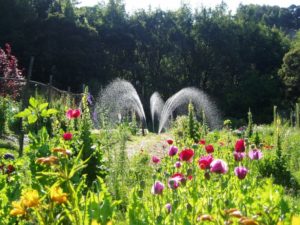 4) Lastly, and possibly the hardest to come to terms with, is that we loved how overhead water made the garden feel. It lowered the overall temperature, kept the paths green and delightful to walk on in bare feet, and well, it looked beautiful. This green oasis provided respite from harsh conditions not just on a biological level, but on an energetic level for so many residents and visitors, human and other-than-human. Landscaper Luke Reppe reflects, “Looking back at older pictures of the garden so lush and green gives me a twinge in my heart.” Even on a garden scale, the emotional impact of drought is real. As we acknowledge and feel the loss as we move into uncertain and scary times ahead, the work of maintaining just relationship means staying open, attuned and creating space for constant change.
4) Lastly, and possibly the hardest to come to terms with, is that we loved how overhead water made the garden feel. It lowered the overall temperature, kept the paths green and delightful to walk on in bare feet, and well, it looked beautiful. This green oasis provided respite from harsh conditions not just on a biological level, but on an energetic level for so many residents and visitors, human and other-than-human. Landscaper Luke Reppe reflects, “Looking back at older pictures of the garden so lush and green gives me a twinge in my heart.” Even on a garden scale, the emotional impact of drought is real. As we acknowledge and feel the loss as we move into uncertain and scary times ahead, the work of maintaining just relationship means staying open, attuned and creating space for constant change.
This isn’t the first time that drip irrigation with dry paths have been trialed in these gardens. In the pre-OAEC days of the Farallons institute, experiments with this popular technique found that the garden was much hotter and annual crops became more easily stressed and less resilient to pests. Unfortunately, hotter and drier is the new, hard reality in a volatile climate.
Garden Manager Michelle Krieg says we need to adjust our expectations. “It’s time to change our aesthetics – not only in our perception of beauty, but also in how we engage with and allow the landscape to express itself. This means, amongst other things, choosing crops and landscaping plants that are appropriate to our Mediterranean/Northern California climate, and continuing to transition more to perennials (as we’ve done in the nursery and elsewhere on the land.)” With creativity and attentiveness, we can likely grow just as much food, co-adapt with our seeds to the changing climate, and find ways to make beauty amidst adversity.
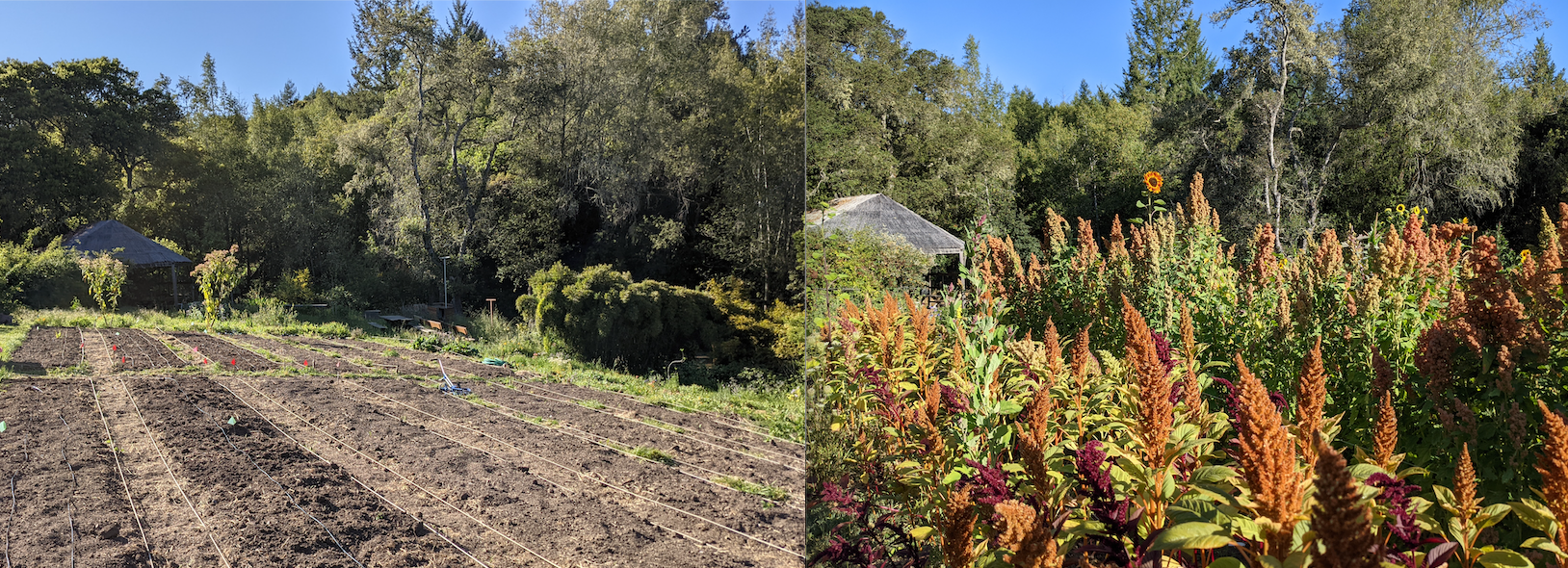
Long time Mother Garden Biodiversity Program Director and OAEC Nursery Manager, Doug Gosling, says that the garden program is five years into a transition plan towards more perennial food crops, culinary and medicinal herbs and pollinator plants. “We have made great strides and will continue with that goal within the gardens themselves as well as the landscaping around the site”. He also advocates for hand watering (with a wand or watering can) sparingly as needed, as an efficient way to save water on a backyard garden scale. He cautions: “While drip irrigation on timers is convenient, automation of a garden’s watering system can have the unintended consequence of breaking the relationship between you and your plants. Hand watering for me is a deeply satisfying, relaxing and contemplative way of being in the garden. Noticing and observing while hand watering is an opportunity to appreciate its beauty and also to discern what your plants might need at any given time.” He encourages gardeners, however they water, to find ways to continue to connect with their plants often, (including checking for leaks and irrigation issues which inevitably arise!), continually watching how the plants respond, and shifting the approach based on the fluctuations of seasonal needs. He also notes that perennials, even California native and other drought tolerant plants, do need supplemental water in the first year to get established, and recommends selective hand watering as a way to provide TLC to individual young plants as needed to keep them, and the relationship, alive.
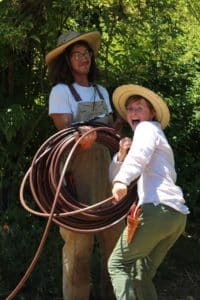
The conversion to drip irrigation is a pretty radical paradigm shift for the OAEC Mother Garden, but if we can do it so can you! We were thrilled to see, according to our calculations, that in the south garden – our sunniest, hottest garden – the conversion to drip is saving over 70%! If nothing else, we encourage everyone to invest in a water meter (James suggests the Hunter HC-075-FLOW and recommends mounting it in a ground box or other frost free zone.) As the saying goes, “If you can’t measure it, you can’t manage it.” Remember, leaks are one of the leading causes of water waste so by tracking how much you normally use, a meter can help you catch wasteful leaks in a timely manner.
As always, at OAEC we will continue to experiment, try new techniques, learn from our mistakes, and share what we’ve learned. We do not pretend to have all of the answers, but believe in the wisdom of nature to continue to guide our path of applied practice. And while individual action is key, collective action is paramount. Without changes in how we govern and manage our economy, our best efforts at the community scale will only be a drop in the bucket compared to the largest water users and climate change exacerbators.
If you are interested in learning about how to install a drip irrigation system, check out resources and classes from our friends at Daily Acts.
